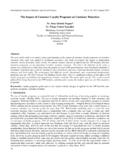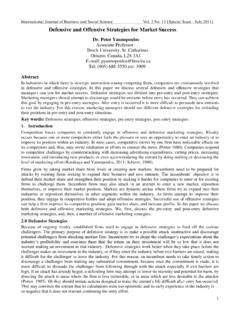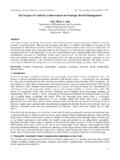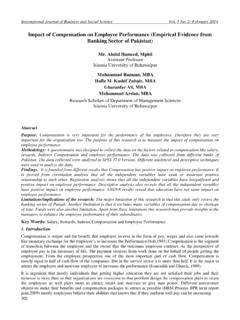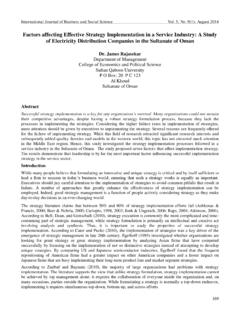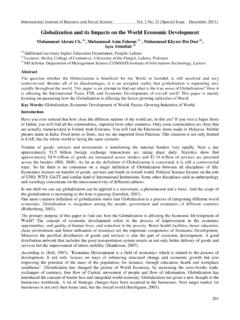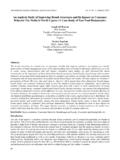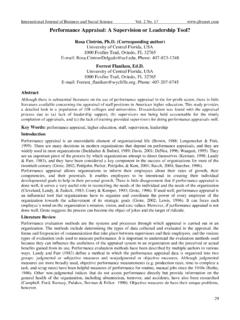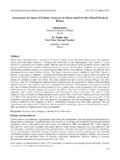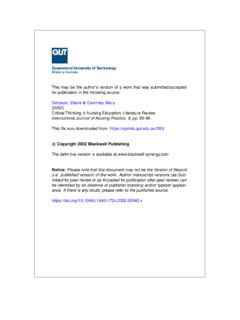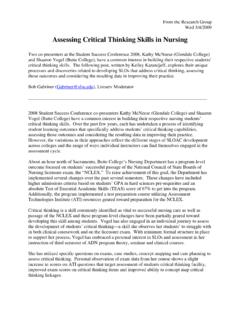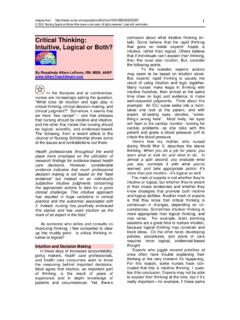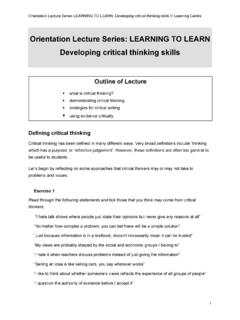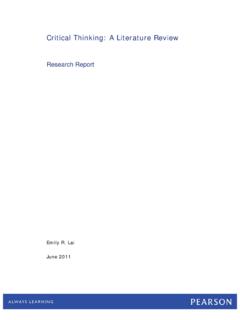Transcription of The Critical Thinking Teaching Methods In Nursing Students
1 International Journal of Business and Social Science Vol. 2 No. 24 [Special Issue December 2011] 174 The Critical Thinking Teaching Methods In Nursing Students Belgin YILDIRIM PhD RN, Assistant Professor Ayd n School of Health Adnan Menderes University Ayd n, Turkey kran ZKAHRAMAN PhD RN, Assistant Professor Faculty of Health Science S leyman Demirel University Isparta, Turkey Seher Sar kaya Karabudak PhD RN, Assistant Professor Ayd n School of Health Adnan Menderes University Ayd n, Turkey Abstract Critical Thinking Thinking explicitly aimed at well-founded judgment, utilizing appropriate evaluative standards in an attempt to determine the true worth, merit, or value of something . Education knits together Critical Thinking ..with the fabric of Students experiences as a synthesizing process, providing Students with the tools they will need to make sense of their world and the choices available to them and the insight they will need to make those choices wisely.
2 The educational process seeks to produce growth in cognivite development, but it is not the only way to achieve growth. Learning and Thinking are processes that, if it nurtured, will continue for a lifetime. An assumption among many educators is that Nursing Students who attend college will develop the necessary Critical Thinking skills simply by attendance in class and participation in class discussion. Class and small group discussions, case studies and the use of Nursing scenarios are very popular with istructors. Educators know that Critical Thinking is enhanced when Nursing Students come to class prepared. When instructors assign written papers, journals, verbal presentations and in class quizzes, Students are encouraged to thoroughly prepare. Students have not endorsed focused Critical Thinking courses as helpful. They tend to favor debate, discussion and the freedom tos hare ideas. Key Words: Critical Thinking , Nursing Student, Teaching Methods Critical Thinking The word Critical comes from the Greek word kritikos, meaning critic.
3 To be Critical means to question, to make sense of, to analyze. By being Critical , one examines his or her own Thinking and the Thinking of others. The term Critical is often thought of in a negative, destructive way; however, using it to describe Thinking can portray a positive process in which one challenges one s Thinking and the Thinking of others (Chaffee, 1994). Despite the attention being devoted to Critical Thinking , educators are still wrestling with defininng the term Critical Thinking . First, the concept of Critical Thinking may differ depending upon whether one s definition is developed from the discipline of philosophy, psyhology, or education. Second, the term Critical Thinking can apply to various frames of reference, referring to such situations as improving reading comprehension, resolving interpersonal conflict, or justifying one s position on a controversial social issue. Third, the application of Critical Thinking can be done in small increments like changing a strategy for a lesson plan or on a large scale like making a comprehensive revision to a curriculum.
4 Fourth, and finally, the nature of Critical Thinking instruction is influenced by grade level, subject area and each teacher s unique Teaching style (Frisby, 1991). As aresult of all these variables, the term Critical Thinking can come to mean different things to different educators. The Special Issue on Business, Humanities and Social Science Centre for Promoting Ideas, USA 175 Richard Paul, a recognized authority of Critical Thinking from philosophy, describes two distinct aspects of Critical Thinking : a narrow, weak sense and a broad, strong sense. The narrow weak sense involves skills that are extrinsic or external to the character of the person, consisting formal, inductiv, and informal logic. In the broad, strong sense, Paul views Critical Thinking as a process that is integrated within the individual, consisting of social conscious effort that is considered essential to the free, rational, autonomous mind (Paul, 1984).
5 Nursing has primarly relied on definitions of Critical Thinking from other disciplines, Badman & Bandman (1995) authored a Critical Thinking text from the perspective of Nursing . These authors define Critical Thinking as the rational examination of ideas, inferences, assumptions, principles, arguments, conclusions, issues, statements, beliefs, and actions . Scheffer & Rubenfeld (2000) report the results of a consensus definition of Critical Thinking spesific to Nursing . An international panel of expert nurses participated in a Delphistudy from 1995 to 1998 to form the following consensus definition: Critical Thinking in Nursing is an essential component of professional accountability and quality Nursing care. Critical thinkers in Nursing exhibit these habits of the mind: confidence, contextual perspective, creativity, flexibility, inquistiveness, intellectual integrity, intuition, open-mindedness, perseverance, and reflection.
6 Critical thinkers in Nursing practice the cognitive skills of analyzing, applying standards, discrimnating, information seeking, logical reasoning, predicting, and transforming knowledge (Scheffer & Rubenfeld, 2000). His definition affirms the importance of the affective domain associated with Critical Thinking as described by the Delphi definition reported by Facione (1990). The Nursing experts, however, included two additional affective components-creativity and intuition. A concern remains however, that based on the way Critical Thinking is addressed in Nursing , a limited understanding of its menaing continues to exist within the discipline (Cody, 2002; Simpson & Courtney, 2002). Y ld r m (2011), Critical Thinking is the process of searching, obtaining, evaluating, analyzing, synthesizing and conceptualizing information as a guide for developing one s Thinking with self-awareness, and the ability to use this information by adding creativity and taking risks.
7 IMPORTANCE OF Critical Thinking IN Nursing Education knits together Critical Thinking ..with the fabric of Students experiences as a synthesizing process, providing Students with the tools they will need to make sense of their world and the choices available to them and the insight they will need to make those choices wisely (Chaffee, 1992). The above assertion incorporates the concepts of Critical Thinking , life-long adult learning and the professional mandates that nurses will practice. Though many schools of Nursing ascribe to these ideals of Critical thinkings skills, many employers feel that too amny Nursing graduates are not able to problem solve and critically think as a new employee. The characterization of Critical Thinking by Dewey (1933) and Ennis (1985) as a unique cognitive thought process, and by Siegel (1988) and Ennis (1962) as a problem solving technique, that uses logical propositions, appears congruent with the Nursing process.
8 Sullivan (1992) state that the scientific method appears to have a better explanation for Critical Thinking in Nursing education than does the Nursing process. Doenges & Moorhouse (2003) described the concept of the Nursing process as resolution by reflection, , the nurse makes an assessment of the problem. During the assessment phase data is collected. Next a diagnosis is made using a knowledge base. A plan of action is then developed. Intervention follows based on the diagnosis and action plan. The last phase is reflection on the choices made and then evaluation of the effects of the interventions used. Reflective Critical thought, a tenet of Critical Thinking as a basis for decision making, was also supported by Paul & Heaslip (1995). They saw reflective thought as necessary to insure that the nurse has the depth of knowledge needed to immediately comprehend the practice situation he or she is faced with.
9 The ability to deliver safe, effective, and quality Nursing care to patients is contingent on the nurse having the necessary knowledge upon which to base decisionmaking. Learning and Thinking are interrelated lifelong processes (Chaffee, 1994). To add depth and substance to knowledge, one must learn to refine and adjust one s Thinking . With practice and time, one can get better at making more thoughtful observations and judgments and can recognize how values are reflected in Thinking and behaving (Y ld r m, & zkahraman 2011d). The educational process seeks to produce growth in cognivite development, but it is not the only way to achieve growth. Learning and Thinking are processes that, if it nurtured, will continue for a lifetime. International Journal of Business and Social Science Vol. 2 No. 24 [Special Issue December 2011] 176 The huge amount of knowledge today, and its continuing exponential growth, precludes a nurse from being an effective professional for long if he or she attempts to function only on the information acquired in school.
10 The information explosion is one factor pointing to the need for lifelong learning (Schank, 1990). Because learning is a life-long process. It is more important that nurses and nurses Students be taught how to think rather than what to think. Consider an analogy that illustrates this point: If you feed a man a fish, he eats for one meal; if you teach a man to fish, he feeds himself for a lifetime. In the same way, if you give nurses and nurse Students few alternatives, then they are limited in their ability to sustain themselves. If you teach nurses to think for themselves, they will have the tools to meet the ever-increasing demands of a lifetime of Nursing practice and Nursing Students practice( zkahraman, & Y ld r m, 2011; Y ld r m, & zkahraman, 2011c). One cannot talk about the importance of Critical Thinking without mentioning the fact that we are living in a complex and evolving society.
